Hello everyone!
After almost two months, here I am again. I won a BAFTA for most unpredictable Boswell blogger, after all, it would have been unusual had I returned sooner. The past two months have been quite busy, but, thankfully, not entirely because of uni. I haven’t got much to say about it, actually, French Phonetics is fine, German too, and the Translation from English into Spanish course is ok, apart from an excess of theory and my constantly feeling like an idiot when we correct the translation in class, since I can’t help my classmates in any way and provide but an acceptable version into the target language. From 2nd into 4th language, I am already doing well, I guess. Wish I could translate into Italian sometimes. I would be a good translator, I think. Most of the translations that now take me hours to translate into Spanish would be done a hundred times more effectively into Italian. What a pity no one cares about translations into Italian. Italian doesn’t matter. But I’m digressing and getting bitter, so let’s get to the point, which is much more cheerful and interesting.
On 11th April I came back from my short holiday back home, in Italy. Achingly short, but what can you do. There was something to look forward to, though, so coming back to Alicante for the last time wasn’t that bad: a great trip to the region of Castile and León with Stefano starting on Tuesday 14th April. We’d been thinking about it for a while, and I really couldn’t wait. Being confined in a corner of Spain, I hadn’t thought I could ever get the chance of going somewhere interesting and see some of the many places of Spain I would have surely seen had I chosen, as I should have, to go and live in Madrid for the Erasmus (crying-over-spilled-milk-mood ON and OFF).
So, when I realised that, after the end of the holidays on 13th April, there would be two days of class and then two more days off thanks to a local holiday, Santa Faz, on 16th and 17th, I immediately decided I needed to get the most of it. ¡Hasta luego Alicante! I got to Madrid on Tuesday night and, given that Stefano had to work on Wednesday and couldn’t travel with me on Thursday, I had two days of tourism on my own. I was exhausted after a 5-hour bus trip, although it had been very comfortable (thanks, Alsa!), but on Wednesday morning at 7.30 I was already on my first Cercanías train, heading to the first destination: Alcalá de Henares. The city centre was nice, I enjoyed the walk from the station to the cathedral in spite of the weather. The university, or what I could see of it, was stunning (it had been the third-choice destination for my Erasmus), and the cathedral was worth a visit. I had come just for a few things, namely seeing the tomb of archbishop Carrillo in the cathedral and the statue of Catherine of Aragon near the archbishop’s palace, because they’re among my favourite historical characters, so, after that, the deed was pretty much done.
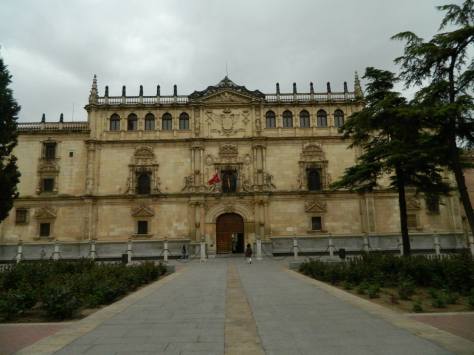
University of Alcalá de Henares
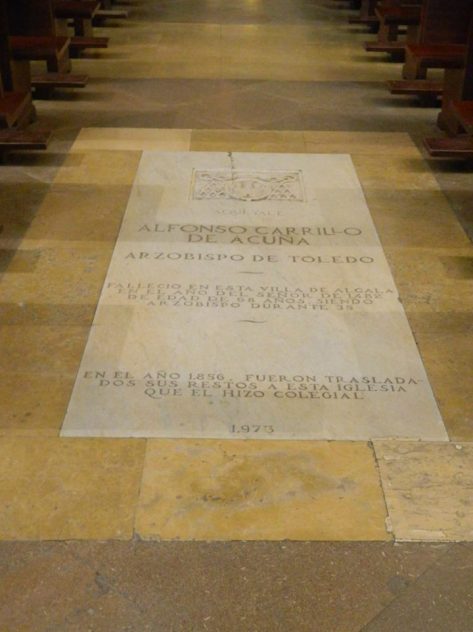
Tomb of His Grace Alfonso Carrillo de Acuña, Archbishop of Toledo and, for many years, powerful advisor to the Infanta and then Queen Isabella I of Castile. Born in Carrascosa del Campo, near Cuenca, in 1410, he died in Alcalá de Henares in 1482.
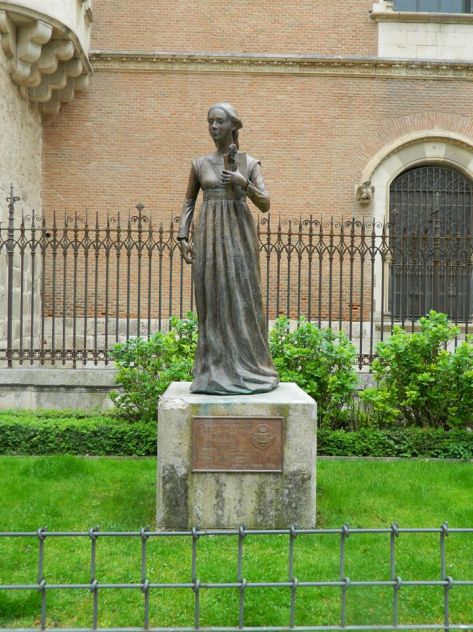
Statue of Catherine of Aragon, youngest daughter of Ferdinand and Isabella, the Catholic Monarchs, and Queen of England as the first wife of King Henry VIII. She was born in the Archbishop’s Palace in Alcalá in 1485.
I got back to Madrid, sleepy but excited, ready for the next leg: Segovia. The journey took about 30 minutes, plus 15 more to get from the station to the actual town (the high-speed train station is in the middle of nowhere, nothing to see but green fields and snow-capped mountains, quite Brontean). Once I got there, the first spectacular sight was the Roman aqueduct:

The Roman Aqueduct of Segovia
I then walked through the centre towards the Cathedral and the Alcázar. It wasn’t a short walk, but it was definitely worth it:

The Cathedral of Segovia, as seen from the Plaza Mayor

Alcázar of Segovia

View from the top of the keep of the Alcázar
In this moment I am quite interested in Spanish Medieval history, particularly in the reign of the Catholic Monarchs, even more particularly in Queen Isabella of Castile, hence visiting the palace where she so often resided was quite a special moment.
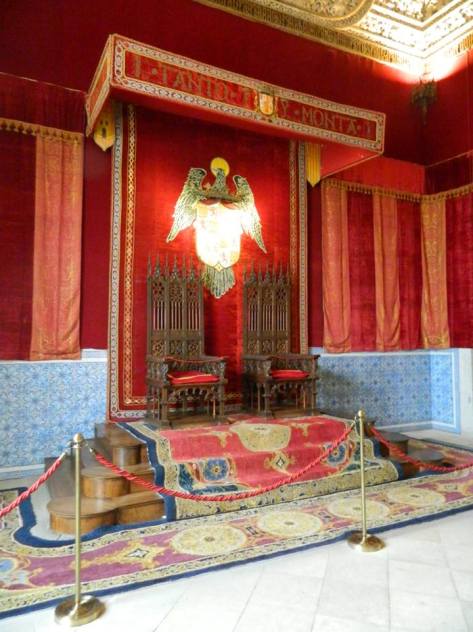
“Tanto monta monta tanto Isabel como Fernando.” (‘Equal opposites in balance, Isabella and Ferdinand’)
I really liked Segovia, there are lots of places to see, the very buildings are imbued with history and culture, I was quite sorry to go…
The second day was to be dedicated entirely to Toledo, about one hour far from Madrid by bus. The weather wasn’t really nice when I got there, it even rained when I was in the Alcázar, visiting the Army Museum, but it got better as the day progressed and I left, at the end of the day, under a scorching sun.

The historical centre of Toledo as seen from the bell towers of the church of St. Ildephonsus, with the Cathedral (on the right) and the Alcázar (on the left)
I visited the Cathedral, one of the three 13th-century Gothic cathedrals of the country, together with León’s and Burgos’, and the abovementioned Alcázar. Had I been more interested in military history I would have surely enjoyed the latter more, but the architecture of the building, both on the inside and the outside, and the views from its terraces made it a nice visit.

The Alcázar of Toledo, now housing the Castilla-La Mancha Regional Library and the Museum of the Army.
The most enjoyable part of the visit, though, was probably just walking along the streets of the centre, in spite of sudden outbursts of heavy rain and large student and tourist groups.
I got back to Madrid and didn’t even go home, as Stefano had planned to pick me up at the station and leave immediately for Salamanca. We drove almost in the dark, which meant that the first view of the city was an amazing skyline, with lights and, standing out against the black sky, the cathedral. I didn’t get the chance to take a picture, but this one I found on the internet is exactly what I saw:
Salamanca by night
We had the chance to meet some friends, Flo and Harriet, in a nice pub with good music, although I think I was perhaps too tired to enjoy it to the full. The evening and following day were entirely spent visiting Salamanca:

Salamanca’s Plaza Mayor

The Cathedral of Salamanca

The Roman bridge

Library of the University of Salamanca
Then, on Saturday, we went to Medina del Campo…

Castillo de la Mota
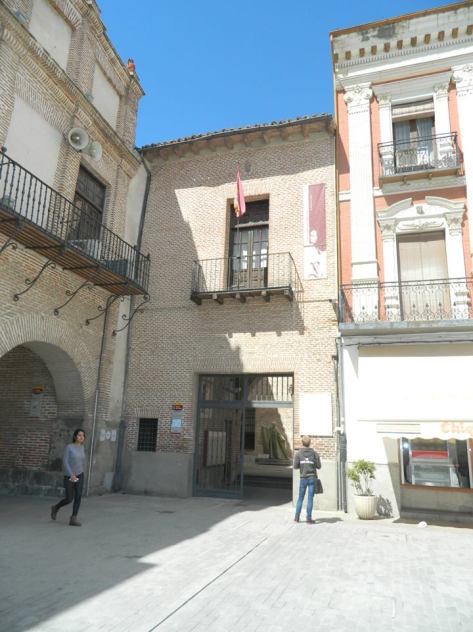
Queen Isabella’s Palacio Real Testamentario (‘Royal Palace of the Last Will’)
… Tordesillas …
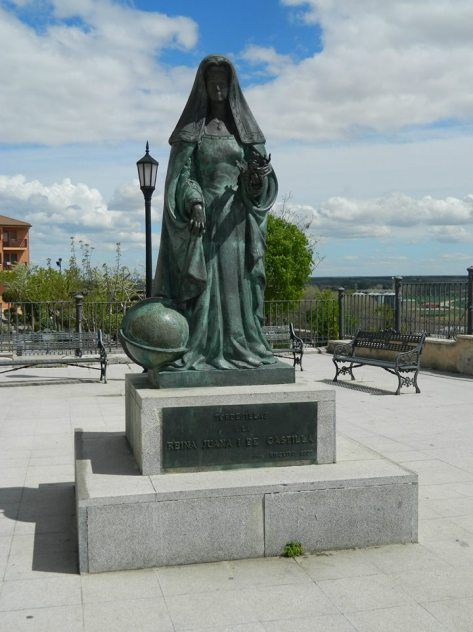
Statue of Queen Joanna I of Castile, known as Joanna the Mad, mother of Charles V, Holy Roman Emperor. Deemed mentally ill in 1506, she was confined in the convent of Santa Clara in Tordesillas, where she remained until her death in 1555.

Casas del Tratado: the palace where, in 1494, the Catholic Monarchs of Castile and Aragon, and John II, King of Portugal, signed the Treaty which established the division of the newly discovered lands outside Europe, following Columbus’ second voyage to the New World.
… and Valladolid.

Plaza Mayor de Valladolid
The very last day was spent first in Arévalo, almost a ghost town (there was literally nobody around, I hope it was because it was Sunday) which I had absolutely wanted to see given its connection to the youth of Isabella of Castile (Stefano was nice enough to indulge me in such a bizarre whim).

Castle of Arévalo
Then the last leg, Ávila, surrounded by a 2.5 km long wall with 88 towers from which there was a lovely view on the surrounding countryside and rest of the city. The weather was so nice, sunny and windy, so it was even more beautiful to have a walk on the part of the walls and on the towers that were accessible to pedestrians. I had fun trying to imagine where the Farce of Ávila might have taken place back in 1465, since I had been told at the tourist office that it hasn’t been located, but any of the vast, emerald-green fields surrounding the walls might have served the purpose.

The walls of Ávila

Panoramic view of Ávila
So, this was the big trip on the road. A very Isabel de Castilla tour, I have to admit, but I thought, If not now, when? It was the right time to do it. I know I haven’t really described much, and let the photos talk for themselves, but I think pictures are sometimes a lot better than words. It was an amazing trip, just what I needed to recharge my batteries and be ready to face the last four weeks of classes, and then exams, of this long year in Spain. I really can’t wait to write the next post of this blog, after the last exam on 9th June. Until then, I’ll disappear once again.
Hasta luego, amig@s.